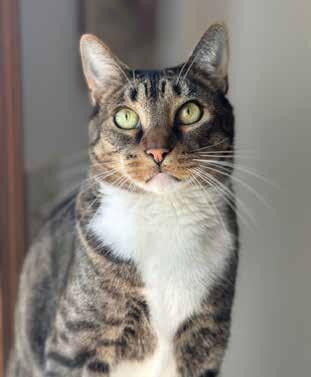

The Home News

Meet the Staff’s Pets!


Rusty
Rusty is a 4-month-old golden retriever! He is completely wild and loves meeting new people, going for car rides and being close to his humans. -Catherine, Associate Publisher and Editor
Luna and Harper
Luna is a 3-year-old black Labrador/pit bull mix and Harper is a heeler mix puppy. -Tony, Art Director


Cash
Cash was adopted from Foxy's Cradle in 2021 and has made himself right at home since Day 1! When he isn't watching the birds or squirrels, he enjoys curling up on the couch, joining his mom on Teams calls, or saying hello to the mailman and neighbors from his favorite spot by the front door. -Keri, Freelance Journalist
Pumpkin and Lyssa

Pumpkin (left) is a 6-year-old little black shadow who’s adorably clueless, endlessly affectionate and as sweet as she is silly. This velcro kitty lives to be as close to her mom as physically possible— preferably draped across her neck, chest or back while head butting her in demand of chin scratches. Lyssa (right) is a 7-pound, 16-year-old calico queen with the softest fur you’ve ever felt and a face that says “I’m judging you” (because she is). This certified diva loves anyone with hands—strictly for petting purposes—and will scream at you with her signature pterodactyl-style squawk for absolutely no reason all day long (when she’s not napping of course). She adores her Mimi, loves her mom, tolerates her sister Pumpkin (barely), and dreams of a blissful life as an only cat. Lyssa refuses to pee in the litter box, preferring puppy pads because, well … she’s Lyssa. -Savannah, Freelance Journalist

Random, Kashi and Sashi
Random (back left), Kashi (back right), and Sashi (front). Kashi and Sashi are litter mates, currently 11, and Random is my grumpy old man who just turned 18. -Laura, Freelance Journalist
Murphy
Murphy is 9 months old and is a golden retriever mixed with Cavalier King Charles Spaniel. He loves playing with his toys, finding sticks in the yard to chew on and chasing his tail. -Danielle, Newspaper Distributor



Alvin is a 7-year-old tabby who was rescued at 8 months old. He loves to watch birds, catch bugs, play fetch and loves to snuggle in bed. Fun fact: Alvin is trained to shake paws for treats!


Home News Staff
When taking your dog for a walk, your main priorities are probably giving them exercise and the opportunity to go to the bathroom. However, there is a third essential component of every walk: sniffing!
While humans have around 5 million olfactory receptors, dogs have around a whopping 300 million. Sniffing is how dogs gather vital information and process the world around them.
Sniffing is not only beneficial for dogs, but essential for their wellbeing as well. While it may be tempting to hurry them along if they are dilly-dallying, giving them that time to sniff is almost as important as the physical exercise itself.
Allowing your pup to sniff to their heart’s
Continued on Page 4

Paul & Lisa Prass
Catherine Stroh
Tony
Danielle Tagliavia - Newspaper Distributor


Letting them sniff
Continued from Page 3
content is extremely stimulating! According to experts, just 15 to 20 minutes of sniffing is equivalent to around an hour’s walk when it comes to enrichment. Think of sniffing like a puzzle-solving session for your dog’s brain; by sniffing they are investigating, analyzing and satisfying their natural curiosity.
Sniffing is also a form of stress relief for your furry friend. Letting them sniff helps them to release feel-good hormones and reduce anxiety. Next time you’re taking your dog for a walk, consider letting them follow their nose. Instead

Show


of deciding the route and expecting your dog to follow, allow them to lead the way by sniffing out a route and following smells that interest them (as long as it’s safe to do so).
Another fun way to let them sniff is by utilizing a snuffle mat. A snuffle mat is a mat that is covered in pieces of fabric with different designs/patterns where you can hide pieces of food or treats to give your dog’s nose a fun workout. This allows your dog to exercise their instinct to sniff and forage. Snuffle mats are especially helpful when the weather does not permit exercising outside. Be sure to supervise your pup when they are using their snuffle mat.

10 BENEFITS OF OWNING A PET









Decreases blood sugar levels for diabetics Lowers blood pressure Lowers cholesterol Helps people socialize Improves children’s development Prevents strokes Improves immunity Improves mood Decreases stress E ases pain



The care you choose for your pet is important.

Human foods That are healthy For your pup
Home News Staff
Let them eat cake! Okay, definitely not cake… but there are some human foods that are extremely beneficial for your dog’s health, in moderation and with no additional ingredients or spices added. Always make sure to research how much is appropriate for your dog’s weight and be aware of any allergies.
Blueberries
Blueberries are a superfood, containing antioxidants, vitamins and fiber.
Pumpkin
Pumpkin can serve as a natural source of soluble fiber and contains vitamins and minerals. Less is more though, so do not overdo it and make sure it is pure pumpkin with no added sugar.
Carrots
Carrots make a great snack with high fiber and vitamins. Consider freezing the carrot first for an extra special treat on a hot day.
Sweet Potatoes
Sweet potatoes contain fiber, supporting a healthy digestive system and contain essential vitamins like B6, C and A.
Bananas
Bananas are another food high in fiber and vitamins and minerals, but again, less is more, so research first how much your pup can have.
Eggs
Eggs are an extremely digestible protein for dogs and aid in increasing nutrient absorption.
Salmon
Salmon is a great source of Omega 3 fatty acids, helping to keep your dog’s skin healthy.
Chicken
Of course we can’t forget chicken! Chicken is a great source of protein, Omega-6 fatty acids, Glucosamine and is easily digestible.






Is your Cat bored?
Home News Staff
While some cats may be happy entertaining themselves and lounging around the house, others might need a bit more stimulation to keep their minds active and stave off boredom. Listed below are some behaviors that might mean your cat is bored.
Zoomies. Otherwise known as frenetic random activity periods, zoomies can be a sign your cat is bored, especially if it happens regularly (daily or more).
Excessive sleeping. While it’s normal for cats to sleep anywhere from 12-16 hours a day, if your cat is sleeping more than usual, this could be a sign of boredom.
Excessive meowing. If your cat is constantly trying to get your attention with excessive meowing, they may be wanting you to entertain them.
Other signs of possible boredom include
pacing, overgrooming, overeating, destroying furniture and furnishings, and attacking humans and other animals.
Be aware that those signs of boredom could also be caused by a variety of things, so if the following solutions do not work, you may need to look into other causes.
1. Play with them
Try to fit in several short play sessions throughout the day to keep your cat entertained, switching up the cat toys each time to keep your cat interested. Some of the best toys for bored cats are fishing rod toys, kicker toys, catnip, puzzle feeders and ping pong balls.
2. Let them explore the backyard or a “catio”
Consider allowing your cat to explore your backyard if it is safe to do so, or invest in a catio, an enclosed space for your cat outside.
3. Provide a window perch
If your cat cannot go outside or has no interest in doing so, consider giving them access to a windowsill or a window perch so they can still enjoy the sights and the sounds of the outside world. For extra entertainment, you could add a bird or squirrel feeder outside of the window.

4. Grow some cat grass
Bring the outside in by planting some cat grass in a pot. Many cats enjoy nibbling on cat grass, and, as a bonus, it may even help them with their digestion.
5. Try training
Training isn’t just for dogs! Cats can be trained as well, and it may provide them with some much-needed mental stimulation.
6. Provide puzzle feeders
You could encourage your cat to work for their food by using puzzle feeders, making mealtime mentally enriching and fun. Puzzle feeders can also help your cat eat more slowly if they prefer to wolf their food down.
7. Give them a groom
Cats may need some help with grooming from time to time, especially long-haired cats who need brushing daily. Grooming can be a great activity to do together and your cat will receive some extra attention.
8. Provide them with something to climb
Consider providing your cat with a cat tower, shelves or walkways up high. Cats typically love to climb high to watch the world from above from a safe vantage point.



Blueberry pumpkin Oatmeal chews
Ingredients
1 cup pumpkin puree (unsweetened)
½ cup blueberries (fresh or frozen)
1 ½ cups oatmeal (rolled oats)
¼ cup coconut oil
1 egg
Directions
Preheat the oven to 350 and line a baking sheet with parchment paper.

Mix all ingredients in a big bowl until well combined.
Scoop spoonfuls onto the prepared baking sheet, flattening into discs or using a cookie cutter for shapes. Bake for 25-30 minutes, or until chews are firm and golden brown. Allow the chews to cool before serving.










Is your child Ready for a Pet?
Home News Staff
A new pet might be at the top of your child’s holiday or birthday wish list, and while it might be tempting to get pulled into the moment and say yes to a new pet, it’s important to be honest about whether or not your child is ready to care for a pet.
1. Is your child genuinely interested?
If a toddler or child under the age of 4 expresses interest in a specific pet, you may want to wait and see if this new interest sticks with time. They may have just read about that type of pet in a book or seen it in a movie.
Once children are between the ages of 5 and 10, perhaps discuss getting a pet if their interest lasts for more than a few weeks or months.
2. Is everyone on the same page about pet care expectations?
If you are expecting the child to be in charge of or help out with pet care responsibilities,

this must be made clear well in advance. However, keep expectations reasonable depending on the child’s age and maturity level. For example, children 12 and older may be able to take the animal on walks, children between the ages of 5 and 12 may be able to help with feeding and grooming, while a toddler may be able to pick up pet toys and refill the pet’s water bowl.
Another thing to consider is the child’s commitment to completing other daily tasks. If they need multiple reminders or it’s a constant fight to get them to complete their other tasks, it might be a similar situation when it comes time to complete pet chores.
3. Which pet is right for your family?
Important questions to consider when choosing a family pet are: How long will the pet typically be home alone? Does your family travel often? Will this pet impact your home environment, and if so, how? It’s imperative that families are honest with themselves and each other about how much extra space they have in their home, their lifestyle and if they can commit to taking care of the animal for years to come.
4. Are there any safety issues?
It is best to always monitor children under


the age of 4 with pets, and you may want to consider waiting until a child is at least 5 or 6 to get a new cat or dog. Older children have more self-control and will understand better the need to give the pet their own space. It may be a good idea to also check whether any children in the home have pet allergies. Allergies aren’t always obvious when children are younger, especially if they haven’t been exposed to those types of animals yet.
5. Is this an impulse decision?
While it may be tempting to surprise your child with a new pet on Christmas morning or for their birthday, pets should never be a spur-of-the-moment decision. Rather, it should be a well-thought out and discussed decision, and children should meet a new potential pet before it is brought home to make sure it is a good match.
Newburg Park 4600 Newburg Road, Nazareth (Entrance on Gremar Road) Lower Nazareth Township’s Saturday, September 13 from 11 a.m. to 3 p.m. (Rain date Sunday, September 14)
DOG’S DAY OUT IV



What to do if your dog is stung by a bee
what to do ahead of time so you can stay calm and collected in times of crises.
1. Remove the stinger with a pair of tweezers.
2. If a honeybee was the attacker and left behind a stinger, gently scrape out the stinger by placing a credit card on your dog’s skin and sliding it to ease out the stinger.
3. Make a paste of baking soda and water and apply to the sting site.


4. Apply an ice pack to relieve pain and swelling.
5. Call your vet to inquire about giving your dog a dose of antihistamine.
6. Provide fresh water and watch them carefully for signs of an allergic reaction.
Allergic reactions typically occur within 2030 minutes after the initial bee sting, but it can sometimes take hours.
If your dog was stung on the head, mouth or nose, watch them closely for several hours for signs of swelling.
If swelling increases dramatically over the course of a few minutes after the sting, get your dog to the vet immediately.




Steps to successfully introduce a New cat to your existing cat
Home News Staff
Introducing a new cat to your home and your existing cat can sometimes be a challenge, but with some planning and moving through the following stages slowly, you can set them up for success.
Basic steps to introducing cats or kittens
1. Set up a sanctuary room
Perhaps using a spare bedroom, prepare a sanctuary room for your new cat with everything they need to ensure they have their own space and time to adapt to their new home.
2. Swap scents
Collect each cat’s scent by using a cloth and wiping it gently around their cheeks or forehead, then give the other cat the cloth to help them get used to each other’s smell. Place the cloth in the middle of the room so they have space to choose to investigate or ignore the cloth.
3. Visual interaction
Once the cats have adjusted to each other’s scents, use a glass barrier, such as patio doors, to allow them to see each other without being able to get at one another. Give the cats the
choice of approaching the glass rather than forcing it. If that is successful, move on to a mesh barrier or a baby gate.
4. Time for face-to-face!
After successful interactions through mesh and/or baby gates, it’s time to try a face-toface meeting. Both cats should be given the option to meet, and both should know where they can safely exit if they need to. Keep the first few meetings short and provide treats as rewards.
Signs of cat bullying
• Staring
• Stealing nap spots or blocking access to owners
• Pouncing on the other cat while they are asleep
• Blocking hallways and doors
• Blocking access to the litter box
To combat bullying between your cats, provide all cat resources (dishes, litter boxes, toys, etc.) in the formula of “one per cat plus one extra,” and position them in different locations to limit competition, and position food bowls away from each other in different rooms.






